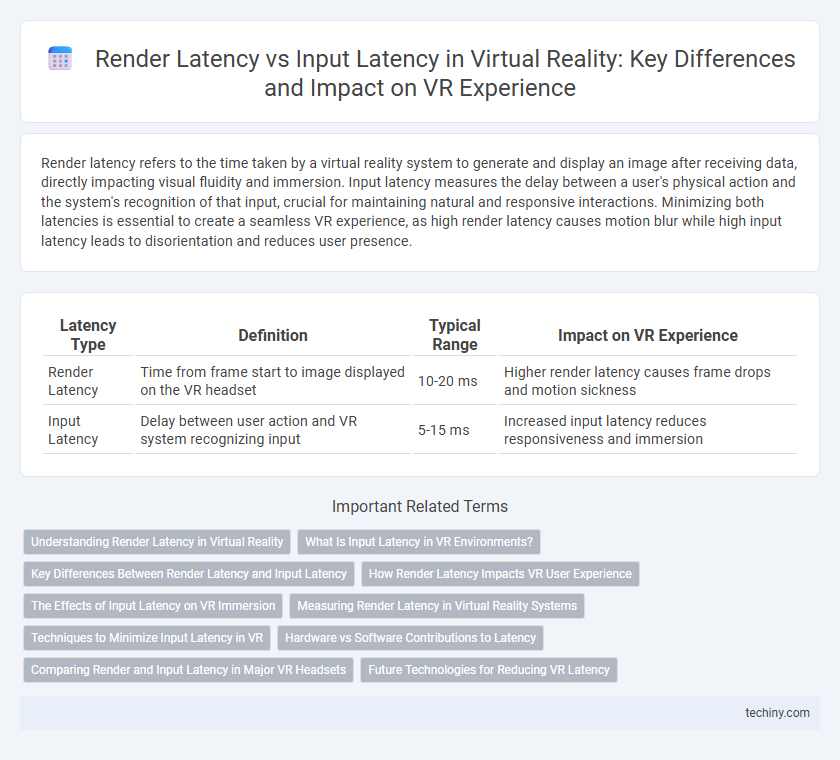Render latency refers to the time taken by a virtual reality system to generate and display an image after receiving data, directly impacting visual fluidity and immersion. Input latency measures the delay between a user's physical action and the system's recognition of that input, crucial for maintaining natural and responsive interactions. Minimizing both latencies is essential to create a seamless VR experience, as high render latency causes motion blur while high input latency leads to disorientation and reduces user presence.
Table of Comparison
| Latency Type | Definition | Typical Range | Impact on VR Experience |
|---|---|---|---|
| Render Latency | Time from frame start to image displayed on the VR headset | 10-20 ms | Higher render latency causes frame drops and motion sickness |
| Input Latency | Delay between user action and VR system recognizing input | 5-15 ms | Increased input latency reduces responsiveness and immersion |
Understanding Render Latency in Virtual Reality
Render latency in virtual reality refers to the delay between the user's movement and the visual update displayed on the headset, directly affecting immersion and comfort. It encompasses the time taken for the system to process input data, render the new frame, and display it, typically measured in milliseconds. Minimizing render latency is crucial for reducing motion sickness and achieving a seamless VR experience.
What Is Input Latency in VR Environments?
Input latency in VR environments refers to the delay between a user's action, such as moving a controller or headset, and the system's response to that input within the virtual scene. Minimizing input latency is critical for immersive experiences, as high input latency can cause motion sickness and reduce realism by creating a noticeable lag between physical movements and their virtual representation. Effective VR systems prioritize low input latency to ensure seamless interaction and maintain user engagement.
Key Differences Between Render Latency and Input Latency
Render latency measures the time taken for the system to generate and display a frame after receiving input, primarily affecting visual responsiveness in virtual reality. Input latency, on the other hand, is the delay between the user's physical action and the system's detection of that input, impacting motion tracking and interaction accuracy. Both latencies are critical for immersive VR experiences, but render latency emphasizes frame production speed while input latency focuses on sensor responsiveness.
How Render Latency Impacts VR User Experience
High render latency in virtual reality causes delayed visual feedback, resulting in motion sickness and decreased immersion. This delay disrupts the synchronization between user movements and the virtual environment, impairing spatial awareness and causing discomfort. Minimizing render latency enhances responsiveness, ensuring a smoother and more natural VR experience.
The Effects of Input Latency on VR Immersion
Input latency in virtual reality directly affects user immersion by creating a noticeable delay between physical movements and corresponding visual updates, which can disrupt presence and cause discomfort. Studies show that even small increases in input latency, typically measured in milliseconds, can significantly degrade the sense of embodiment and spatial awareness within VR environments. Minimizing input latency to under 20 ms is crucial for maintaining seamless interaction and enhancing the overall immersive experience in VR applications.
Measuring Render Latency in Virtual Reality Systems
Render latency in virtual reality systems refers to the delay between the user's action and the visual update on the display, significantly impacting immersion and user experience. Measuring render latency involves using high-speed cameras or photodiodes to capture the time elapsed from input signal processing to frame presentation, providing precise timing data essential for optimizing VR performance. Accurate render latency measurement ensures synchronization between head tracking, graphics rendering, and display output, reducing motion sickness and enhancing realism.
Techniques to Minimize Input Latency in VR
Techniques to minimize input latency in VR include predictive tracking algorithms that anticipate user movements to compensate for sensor delays, ensuring smoother interactions. Hardware enhancements like high-speed sensors and low-latency communication protocols reduce the time between user input and system response. Software optimizations such as asynchronous reprojection and input buffering further decrease perceptible lag, improving overall immersion and user experience.
Hardware vs Software Contributions to Latency
Render latency primarily stems from GPU processing speed and display refresh rates, with high-performance graphics cards significantly reducing frame rendering times. Input latency is influenced by hardware factors such as sensor sampling rates and controller responsiveness, as well as software components like OS input handling and driver optimization. Optimizing VR performance requires balancing hardware upgrades with software improvements to minimize total latency and enhance immersive experience.
Comparing Render and Input Latency in Major VR Headsets
Major VR headsets exhibit varying render latency and input latency, impacting overall user immersion and responsiveness. For example, the Valve Index typically maintains render latency around 20 milliseconds, with input latency closely aligned, ensuring fluid motion tracking. In contrast, standalone headsets like the Oculus Quest 2 show higher render latency near 30 milliseconds, while input latency remains relatively low, highlighting differences in processing power and wireless data transmission.
Future Technologies for Reducing VR Latency
Future technologies in Virtual Reality aim to minimize render latency and input latency by leveraging advanced techniques such as foveated rendering combined with AI-driven predictive tracking algorithms. High-speed GPU architectures and 5G-edge cloud computing frameworks enable near-instantaneous frame rendering and data transmission, significantly reducing lag. Emerging neural rendering methods also promise to accelerate image synthesis, enhancing real-time immersion and responsiveness in VR environments.
render latency vs input latency Infographic

 techiny.com
techiny.com